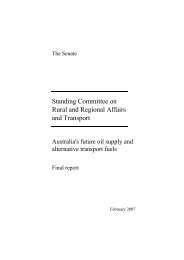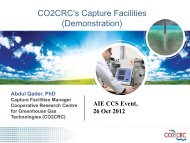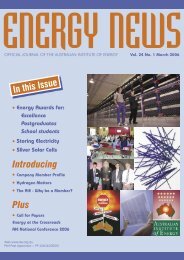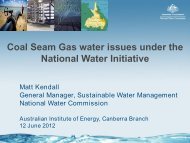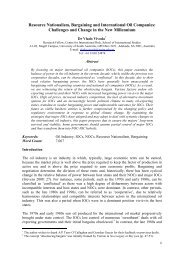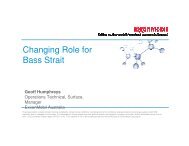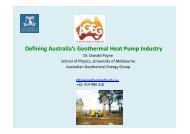Jun 2007 - Australian Institute of Energy
Jun 2007 - Australian Institute of Energy
Jun 2007 - Australian Institute of Energy
You also want an ePaper? Increase the reach of your titles
YUMPU automatically turns print PDFs into web optimized ePapers that Google loves.
The Methane to Markets Partnership<br />
By Saravan Peacock,<br />
Assistant Director, Bilateral Climate Change Partnerships, <strong>Australian</strong> Greenhouse Office<br />
In October <strong>2007</strong> the international Methane to Markets<br />
Partnership (M2M) will take its collective expertise to<br />
Beijing to showcase opportunities to generate energy (and<br />
pr<strong>of</strong>its) from methane. The Beijing Expo will bring together<br />
project developers and financiers, technology manufacturers<br />
and vendors, and government policy-makers to exchange<br />
ideas and showcase new projects. A range <strong>of</strong> <strong>Australian</strong><br />
companies and researchers are already planning to attend<br />
the expo to see the latest technologies, explore new business<br />
opportunities and exchange ideas and experience with<br />
practitioners in key markets like China, the United States,<br />
India and Europe.<br />
Methane is a valuable energy resource that is <strong>of</strong>ten wasted<br />
by companies and governments across many sectors <strong>of</strong> the<br />
economy. It is also a major contributor to global greenhouse<br />
gas (GHG) emissions, being 23 times more effective than<br />
carbon dioxide at trapping heat in the atmosphere. As energy<br />
costs increase and governments look to reduce greenhouse<br />
gas emissions there are huge commercial opportunities to<br />
convert wasted methane to energy through already proven,<br />
cost-effective technologies.<br />
Since the industrial revolution, methane concentrations in<br />
the atmosphere have more than doubled, largely because <strong>of</strong><br />
human activity. Methane now accounts for 16% <strong>of</strong> all GHG<br />
emissions globally, with about 60% <strong>of</strong> total methane emissions<br />
coming from anthropogenic (human-related) sources.<br />
As well as reducing emissions and promoting pr<strong>of</strong>its,<br />
projects that capture and use methane can also facilitate<br />
broader economic development, strengthen energy security<br />
and improve local living conditions such as air quality and<br />
industrial safety. For example, capturing methane from<br />
underground coal mines improves safety conditions by<br />
reducing explosion hazards.<br />
INTERNATIONAL COOPERATION<br />
M2M was formed in 2004 to capture these benefits by<br />
promoting methane’s cost-effective capture and use as a<br />
clean energy source in the near term. M2M targets four<br />
major methane sources: animal waste management, coal<br />
mines, landfills, and natural gas and oil systems. National<br />
governments, private sector entities, development banks,<br />
non-governmental organizations, financial and technical<br />
experts, and other interested parties work together to<br />
develop methane capture and use projects internationally.<br />
There are currently 20 member countries and more than 500<br />
companies, pr<strong>of</strong>essionals and organisations involved in the<br />
partnership. M2M achieves its goals by facilitating public<br />
Articles<br />
and private sector investment in projects that capture and use<br />
methane. Partners work together to both identify barriers to<br />
the development <strong>of</strong> projects and support activities to help<br />
overcome these barriers. These activities include capacitybuilding<br />
workshops and other training events, technology<br />
transfer, feasibility studies, and technical assistance. Partners<br />
also work together to identify and assess potential project<br />
sites and to clarify regulatory and legal issues.<br />
The Methane to Markets Partnership Expo in Beijing<br />
from 30 October to 1 November <strong>2007</strong> is the premier<br />
international forum for promoting project opportunities<br />
and technologies that capture and use methane. The expo’s<br />
technical programme will include four sector-specific tracks,<br />
along with presentations, training, and other sessions. The<br />
expo will be hosted by China’s National Development and<br />
Reform Commission and the United States’ Environmental<br />
Protection Agency along with China’s major industry<br />
departments and three major Chinese state-owned oil and gas<br />
companies. Among the major sponsors for the event is the<br />
Asian Development Bank, which has extensive experience<br />
with clean energy projects. The <strong>Australian</strong> Government will<br />
have a stand to promote <strong>Australian</strong> companies and expertise,<br />
and to highlight the work Australia is doing to promote the<br />
worldwide capture and use <strong>of</strong> methane.<br />
Figure 1: Australia’s sector contributions to methane emissions, 2005<br />
Action in each <strong>of</strong> the partnership’s four key target sectors<br />
– coal mine methane, landfill gas, oil and gas, and the<br />
agriculture sector – is coordinated by a subcommittee with<br />
its own action plan focussed on sector-specific issues.<br />
39 EnErgy nEws Vol 25 no. 2, <strong>Jun</strong>e <strong>2007</strong>



